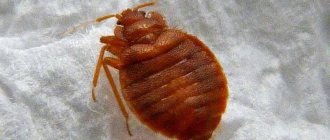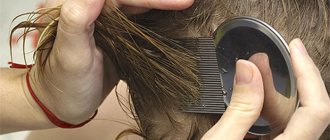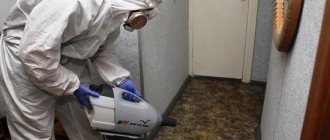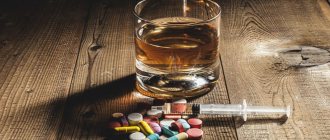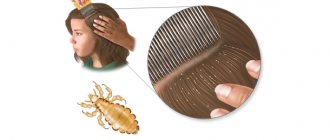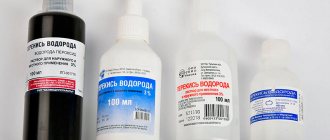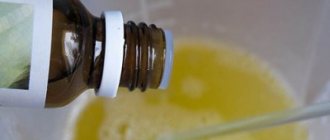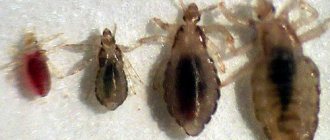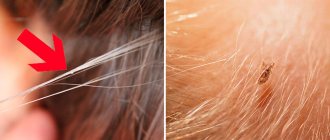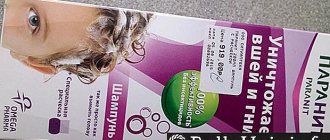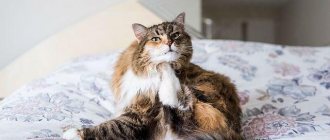Why does my head itch?
The curls are treated with anti-parasite shampoo, no lice are visible, but you still want to scratch your scalp. There are several reasons why the lice were removed and the head itches:
- Unhealed wounds cause discomfort for 2-3 days. This period must be endured. The less often you touch bite marks, the faster they will go away.
- Psychological factor. A person is accustomed to the fact that insects live in his hair. After removing them for about two days, the feeling that the head is itching from nits and lice persists.
- New insects. You cannot treat your head with the drug once. After a week, new lice will appear from the preserved eggs. If your skin begins to itch two weeks after treatment, you should check your hair again.
- Allergy. Most pharmaceutical drugs can cause itching and redness. Before you start removing parasites, you should take a test. Apply a little product to your wrist or elbow, rinse off after an hour and wait a day. If the area does not turn red, then treatment can begin.
Traditional recipes for head lice can also cause discomfort. Therefore, before you start treating your hair for lice, you should consult a doctor.
What is a head louse?
A louse is a small blood-sucking parasite that lives on the scalp of a person and feeds on his blood. Insects feed using a special oral apparatus that allows them to easily bite through the skin of their host. In places where the skin is damaged, irritation occurs, which is accompanied by itching. It is this symptom that allows one to suspect head lice in a person, which, as a rule, is complicated by infection and inflammation of the wounds due to constant scratching of the skin.
The head louse is perfectly adapted for parasitism: its legs with claw-shaped segments cling tightly to the surface of the hair, allowing it to quickly move across the surface of the skin, and its durable body can easily withstand a load of up to 1 kg. The insect feeds 2–3 times a day, sucking out several milligrams of blood with the help of its pointed proboscis, while changing its color to reddish or purple. You can look at a louse under a microscope in the video:
Symptoms of lice
The skin begins to itch and spots appear on the body. Some people believe they have an allergy and take antihistamines. But the unpleasant sensations on the skin continue to bother me. The cause of the rash and discomfort can be a tiny parasite - a head louse, a pubic louse or a body louse.
- The appearance of blue spots in the groin or on the body.
- Itching of the occipital and temporal areas of the scalp, which intensifies at night and after water treatments.
- The appearance of white grains at the base of the hair.
- The presence of small insects on the head, in the armpits, in the groin, on clothes.
Children suffer the most from pests. The disease progresses quickly and even after treatment for lice, the skin does not stop itching. Unpleasant sensations can be caused by unhealed wounds from lice bites or insect repellent medications.
Remedies for head lice can cause allergies or burns. Therefore, if a burning sensation occurs on the skin during treatment, the drug should be washed off immediately.
Signs and symptoms of lice
An adult may not immediately recognize the symptoms of head lice. This happens after about two weeks. The appearance of lice can be caused by unfavorable sanitary conditions, or through close contact with an infected person.
You can recognize the presence of this type of parasite by the main signs:
- Itching. Unpleasant sensations appear immediately in the back of the head and temples.
- Appearance of a rash. After lice bites, red spots form on the head, which can also be accompanied by negative sensations.
- The appearance of marks from scratching. Itching is provoked by excessive scratching by a person of areas of the hairline, as a result of which suppurated crusts appear.
- Hair deterioration. Hair is dry and brittle
- The appearance of nits. Nits attach to the hair. They are small in size (2 mm), color – white or silver.
In the first weeks, it is quite difficult to detect the appearance of small insects, since the itching may be minor. In this case, the person will not even pay any attention. Careful inspections must be carried out to detect the problem.
Life cycle of a louse
The reproduction of lice in humans also has a number of its own characteristics. These parasites prefer to live and reproduce at a temperature of about 28 ° C, which is normal for the human scalp under normal conditions. If the ambient temperature drops below 12 °C, the reproduction and development of lice stops, which is why the peak incidence of lice occurs in the warm season.
To continue their lineage, these insects lay eggs - the so-called “nits”, attaching them to the hair with a special sticky secretion, which is useless in trying to wash off with water. This substance has excellent adhesion to the surface of the hair, which helps prevent egg loss. During her short life, one female lays about 100 eggs - approximately 4 - 5 pieces per day.
There is only one way to get rid of nits - by combing them out using a special fine-toothed comb. You can first dilute a little vinegar in a large amount of water and treat the scalp - this will help dissolve the sticky substance and make combing easier.
Since complete removal of nits by mechanical means still does not occur, after a week it is recommended to treat them with shampoos or creams that will kill the parasites that have already hatched, but have not had time to turn into adults.
In general, the full development cycle of lice under favorable conditions is about 16 days. Otherwise, the development of an insect from a nit to an adult can reach 30 days. Approximately 8 days after laying the eggs, the first larvae begin to appear. They are almost identical to adult parasites, with the exception of the presence of genital organs and the same body size.
Types of lice
Human lice are small in size, about the size of a sesame seed.
They are colored gray-brown and have 6 legs, thanks to which they quickly move through the hair. If a louse has drunk blood, it turns red or black. Lice feed constantly so as not to die. The insects lay yellowish oval eggs no larger than a millimeter in size, from which a new individual emerges a week later. Otherwise, the eggs are called nits; they can easily be confused with dandruff, but unlike dandruff, they are firmly glued to the base of the hair with a special substance. They cannot be shaken off from the hair, so the nits are carefully combed out after the treatment. Head, pubic and body lice can live on humans, each of which differs in size and location of accumulation.
Head louse
Lice in the human head are distinguished by their dark color and long abdomen. They are called cephalads because they are concentrated on the hair, females are larger than males. This type is characterized by rapid reproduction. After laying an egg, only 16 days pass until the female matures with reproductive ability, and under unfavorable conditions - a month. The head louse is extremely productive - during its life, which lasts up to a month, it lays 80-100 eggs. It turns out that she lays 3 eggs a day, which quickly turn into adults and pester the patient.
The life cycle stages of the human head louse that causes pediculosis are:
- an egg measuring 1 mm takes a week to develop;
- 3 stages of the nymph, during which the future insect grows, molts, and in 3 days turns into a nymph of the first age, in 5 - the second, in 8 - the third;
- stage of an adult insect - the nymph molts and is ready to reproduce; she begins to mate with males immediately after emerging from the nymph.
Pubic louse
Darkish in color with a wide, strongly shortened abdomen, lice belong to the pubic area. Their habitat is the groin, buttocks, armpits, eyebrows and eyelashes. Pubic insects differ from cephalic insects in the structure of their legs, but their development cycle is similar due to the same breeding conditions. Females lay up to 50 nits, they intensively feed on blood, form nymphs of the first, second and third order, then an adult hatches - an adult.
Cootie
Body lice live on clothing and in chest hair. They look like head ones, but are distinguished by a yellowish color without black dots on the abdomen. These lice lay over 300 eggs during their lives and are highly resistant to cold and starvation. Nits, nymphs and adults can only be destroyed by boiling. Body insect bites are similar to scabies; the blood spots turn into follicles and become inflamed.
How are they transmitted?
To avoid such an unpleasant disease as lice, it is important to know about the routes of transmission of parasites, since most people cannot even answer the question “Do lice jump or crawl?” Meanwhile, you can become infected with these insects in several ways:
- Lice can crawl from one person to another. This is the most common type of transmission, usually occurring in children who play together and those who sleep in the same bed.
- When sharing personal hygiene items with several people, head lice are also transmitted through various accessories and hair care items: towels, elastic bands, combs, hoops. Having accidentally landed on one of these things, the parasite then crawls from it onto the skin of a healthy person.
- You can also become infected through clothing. Most often these are things that come into contact with the scalp in one way or another: hats, scarves, hoods, etc.
- In some cases, it is quite possible to contract this unpleasant disease by using the bedding or pillow of a lice carrier.
- Since louse eggs themselves cannot move, it is extremely rare to become infected with them - only through mechanical transfer by a person himself to the surface of the scalp.
Anyone who has at least one louse in their hair can be considered a carrier of this disease, even if there are no signs of lice. Of course, the risk of infection increases in direct proportion to the number of insects, since the likelihood that they will crawl or fall on clothes and other objects also increases.
So can lice jump? Fortunately, no. The massive body does not allow insects to move too actively. Special hook-shaped growths on the legs are designed to firmly cling to the hair, but at the same time they do not give the insects the opportunity to jump anywhere. The impossibility of transmitting lice over a distance allows you to calmly communicate with its carriers without exposing yourself to the risk of infection, since lice are transmitted only through direct contact.
If you notice at least one of the signs of head lice, you will have to carefully examine yourself for the presence of parasites, since getting rid of head lice is not an easy task. You cannot let the treatment process take its course - this is fraught with the rapid spread of the disease not only within the family circle, but also among other people. Of course, a slight itching does not mean that uninvited guests have appeared in the head, because there are a great many reasons why the head itches if there are no lice, and only the attending physician should consider the likelihood of any of them in each specific case.
How to understand that you have exactly “this” thing
Why is it difficult to recognize the damage to the body by parasites in time? Treatment of the disease is complicated by the fact that a long period of time (up to several weeks) can pass from the moment of infection to the moment the first symptoms appear. The most common symptom is itching, which can persist for quite a long time. Moreover, not only the scalp itches, but also the area around the ears, temples, and the back of the head.
The second sign is the appearance of a rash that appears a few days after the insect bite. The head form is characterized by the formation of red spots over the entire area of the scalp. Body lice (the second type of the disease) can more often lead to widespread pigmentation, as a result of which the skin acquires a bluish tint. Pediculosis pubis causes the appearance of bluish spots in the thighs, groin area, and lower abdomen. Why does the skin turn this color? The blue color is a consequence of the breakdown of hemoglobin after bites, which stains the skin.
A long course of the disease, when the head is constantly itching, leads to severe scratching of certain areas of the skin that are affected by lice. Subsequently, purulent crusts form in these places, which cause discomfort even after the insects are eliminated.
By the way, here are the main complications of untimely removal of lice:
- secondary bacterial infection;
- blepharitis, conjunctivitis (eye lesions);
- typhus and other infectious diseases;
- lymphadenitis or damage to the lymphatic system;
- sepsis and others.
If you do not get rid of blood-sucking lice in time, not only can the scalp itch with further formation of crusts, but also the parotid lymph nodes can often swell. There is also a high risk of infection through open wounds that appear after scabs are torn off when the skin is very itchy. Why should you immediately seek medical help from an experienced specialist if you suspect a disease? He will prescribe effective treatment depending on the severity of the disease, the area affected, the patient’s age and other factors.
Are you sure you are free of lice?
How long does the period of destruction of parasites last, and why is it so difficult to get rid of them? Treatment of pediculosis consists of destroying not only adult lice, but also existing nits, which after a certain time pass into the adult stage. To get rid of lice, modern preparations are used, which are diluted in the required concentration and applied to the surface of the scalp, where it itches the most. After this treatment, they are washed off with shampoo.
For faster and more effective treatment, it is advisable to completely cut off the hair, which greatly facilitates the treatment of the skin. If it is impossible to shave your hair, it is recommended to regularly comb your hair with a special comb. Why is thorough brushing required? This is necessary to remove dead nits. Also, you should not stop hatching halfway through the course, since it is important to get rid of both adult lice and laid eggs.
Additionally, at all stages of treatment it is necessary to monitor hygiene and use individual care products (towel, bed linen, comb), since the disease quickly spreads to healthy family members. It is also advisable to temporarily abandon clothing that may cause re-infection (with hoods, collars). How long will it take? Considering that the larvae hatch from the egg within 14 days, it is enough not to use things after thorough treatment for 2 weeks. An adult insect is not able to live for long without a food source, which is about a week.
Why does my head itch after lice treatment?
Are you sure that you are completely free of parasites? A complete therapeutic course for the treatment of pediculosis should affect not only adult individuals, but also nits. If this does not happen, then the laid eggs simply grow into adults and continue the life cycle of the louse, causing the same inconvenience.
In order to simplify the treatment process and increase its effectiveness, you can completely shave your head. If for some reason this is not possible, then the hair should be thoroughly combed several times a day with a comb or comb. This is done to remove dead lice and nits from the surface of the scalp.
The following ailments not related to pediculosis can also cause head scratching:
- nervous shocks and emotional stress;
- allergies to hair care products;
- hormonal disorders;
- seborrhea and other fungal diseases;
- dry skin with a lack of vitamins A, B, C.
Not only the head, but also personal hygiene items, as well as clothing, should be thoroughly disinfected. Larvae from eggs could remain on clothing if it has a hood or a large collar. Also, carelessness in clothing may explain why children's heads itch if there are no more lice.
Don't forget about preventive measures
After treatment and as a preventive measure, it is necessary to follow simple measures that will allow you to avoid experiencing unpleasant sensations in the future. In addition, even after removing the insects, itching and burning may persist for a long time. How long the discomfort can last depends on the shape, stage and area of the lesion.
You should avoid the following actions:
- use someone else's combs, towels, headphones;
- change clothes and other accessories;
- visit the pool without a rubber cap;
- be sure to wash bedding and underwear in hot water, then iron them thoroughly, paying special attention to the seams;
- boys should have their hair cut regularly;
- after getting rid of lice, periodically use repellents (for example, lavender oil, tea tree oil, hellebore water);
- Wash your hair weekly with a special shampoo.
The patient may continue to scratch the skin on a subconscious level. Why is this happening? The answer is simple - habit. It may be worth paying attention to the state of the nervous system, which becomes unstable when affected by parasites.
If your head still itches after lice, you can try simple folk methods.
To soothe the skin it is recommended:
- Regularly rinse your hair with a weak solution of apple cider vinegar or lemon juice;
- systematically apply a Hercules mask (1/2 cup of flakes per glass of boiling water);
- rub burdock oil into the scalp weekly;
- add 4-5 drops of tea tree oil to the rinse water.
Preventive actions
Even when it has become clear why the head may itch, if there are no lice, it is advisable to treat the skin to reduce discomfort. Prevention of causeless itching should be comprehensive and may be limited to folk recipes.
Decoctions of chamomile and string
Ingredients:
- chamomile – 2 tbsp;
- string - 2 tbsp;
- boiling water – 1 liter.
Boil over low heat for 1.5-2 minutes, leave for half an hour, then strain and rinse your hair in the morning and evening.
Oatmeal mask
You will need:
- crushed Hercules - 0.5 tbsp.;
- boiling water – 1 tbsp.
After swelling, the paste is applied to the scalp, left for half an hour and washed off with cool water.
Tea tree oil
A well-known soothing and regenerating agent that is added to water before rinsing. Be sure to check first to see if you are allergic to the oil.
Home control methods
If serious treatment is not required, folk remedies are effective in relieving scalp itching. They quickly relieve discomfort and restore the functioning of skin cells.
1. Tea tree oil. Not only is it a natural remedy in the fight against infections and fungal diseases, but it also effectively eliminates dryness. You can add a few drops to shampoo and wash your hair with the mixture daily. It is also recommended to make masks with the addition of oil: 1 tbsp. vegetable oil, 3-4 drops of tea tree oil, rub into the scalp and leave for an hour.
2. Lemon juice. For itchy scalp, it is recommended to apply the juice to the skin in its pure form or dilute it in water in equal quantities 5-10 minutes before washing. Lemon is also used to prepare medicinal masks (for example, mixed with natural yogurt or kefir).
3. Baking soda. If you have dandruff, flaky and itchy scalp, regular baking soda will help. You need to mix 1-2 tsp. baking soda, add a small amount of water (to a paste-like consistency), apply the resulting mass for 15-20 minutes, then rinse with warm water.
4. Apple cider vinegar. This remedy perfectly combats scalp itching, restoring the Ph level. Additionally, vinegar relieves inflammation, eliminates irritation and dry skin. Apply a solution of water and vinegar (1:1 ratio) to clean and dry hair using cotton pads or a spray bottle.
What to do if lice have been removed and your head itches. How long can your head itch after head lice? The main causes of itchy scalp after lice.
Even today, the diagnosis of pediculosis is often heard. Its cause is the presence of lice - the smallest insects that live on the human head. This parasite feeds on blood; as a result of its bites, the skin begins to itch severely. However, there are times when the head itches even after removing lice. This situation develops for various reasons, it could be an allergic reaction to the drug used, or burns from its improper use.
Decoctions of chamomile and string
Ingredients:
- chamomile – 2 tbsp;
- string - 2 tbsp;
- boiling water – 1 liter.
Boil over low heat for 1.5-2 minutes, leave for half an hour, then strain and rinse your hair in the morning and evening.
Oatmeal mask
You will need:
- crushed Hercules - 0.5 tbsp.;
- boiling water – 1 tbsp.
After swelling, the paste is applied to the scalp, left for half an hour and washed off with cool water.
Tea tree oil
A well-known soothing and regenerating agent that is added to water before rinsing. Be sure to check first to see if you are allergic to the oil.
Dandelion with lemon
In the treatment of itchy scalp with folk remedies, you can use dandelion and lemon. Both components saturate the body with nutrients, suppress the activity of fungal microflora and eliminate inflammation.
To prepare a remedy for itching and dandruff you need:
- collect fresh dandelion flowers and mix with vodka;
- the resulting composition is infused for 12 days in a dark room;
- at the end of this period, lemon juice is added to the mixture.
To get rid of itchy scalp and dandruff, you need to treat problem areas with the product every day, covering them with a towel for 25-30 minutes.
Another natural remedy that you can do if you have dandruff and an itchy head is mint. The substances that make up the plant tone the dermis and normalize the functioning of the skin glands.
- Treatment at home can be done using essential hair oil based on mint. 3 drops of this product must first be diluted in a liter of water.
- Mint infusion is considered effective against itching and dandruff. To prepare the remedy you will need 5 teaspoons of the plant. Mint should be poured with a liter of boiling water and left for half an hour.
We suggest you read: Quarantine due to lice
Both products can replace traditional shampoos during the treatment of skin pathologies.
Linden decoction
If dandruff appears and your head itches, a decoction of linden helps get rid of the unpleasant symptoms. The plant contains many nutritional and beneficial elements that have a beneficial effect on the skin and suppress the activity of fungal microflora.
When a lot of dandruff with itching appears, you need to take 2-3 liters of water and dilute the linden tree at the rate of 1 tablespoon of the plant per 450 ml of liquid. The resulting composition is evaporated in a water bath for 25 minutes. At the end, the product is filtered.
Linden decoction should be used once a day. Treatment of the skin with this remedy takes no more than 2.5 weeks.
Treatment with vinegar
Vinegar is used for dandruff and itchy scalp when symptoms are due to fungi or infections. To prepare the remedy you will need 100 ml of warm water. A tablespoon of 9 percent vinegar should be diluted in it.
After applying the product, cover with polyethylene for 30 minutes. At the end of the procedure, the hair is washed with warm water. Using vinegar, you can cure severely itchy skin.
Essential oils
If your head suffers from dandruff caused by the activity of fungal microflora, the following will help you cope:
- tea tree oil;
- tangerine and caraway oils;
- cinnamon oil.
When dry scalp itches, it is recommended to treat problem areas with essential oils from:
- chamomile;
- incense;
- sandalwood;
- palmarosa.
These oils not only relieve dry skin, but also suppress the inflammatory process, so the skin stops itching.
Onion
Onion juice and peel is another folk remedy that can be used to treat the skin when it itches.
- The juice should be used in case of severe allergic reactions to hair dye. Add a little lemon juice to the onion juice and mix with vegetable oil. The resulting composition must be applied to the hair and left for 30 minutes.
- A decoction of onion peels helps cure severely itchy skin. It must be placed in an enamel bowl and filled with boiling water. Then the mixture is placed on low heat for 1 hour. The decoction should be applied to the hair after washing with shampoo. The product also helps to cope with lice.
Apple
Another way to get rid of dandruff and itchy scalp is chopped apple. To remove unpleasant sensations, the paste should be rubbed into the scalp and hair and left for 40 minutes, covered with a towel. It is recommended to repeat the procedure three times a week.
To get rid of itching and flaking of the skin, you can use the following masks:
- Honey mask. You will need aloe juice, squeezed from a plant leaf. It must be mixed with 4 tsp. honey and egg yolk. The mask should be applied evenly to hair and skin and left for 40 minutes.
- Vitamin mask. You need to mix baby cream with two capsules of vitamins A and E. The mask is left for 40 minutes.
- Banana mask. You will need 1 tbsp honey and 1 tsp. onion juice. Both ingredients should be mixed with half a banana. The mask is also kept for 40 minutes.
What does traditional medicine advise?
There are many folk remedies for dandruff and itchy scalp. When choosing a prescription for treatment at home, it is also necessary to take into account the cause of the development of these symptoms. Traditional medicine complements the main treatment and is designed to reduce the intensity of clinical phenomena.
Dandelion with lemon
In the treatment of itchy scalp with folk remedies, you can use dandelion and lemon. Both components saturate the body with nutrients, suppress the activity of fungal microflora and eliminate inflammation.
To prepare a remedy for itching and dandruff you need:
- collect fresh dandelion flowers and mix with vodka;
- the resulting composition is infused for 12 days in a dark room;
- at the end of this period, lemon juice is added to the mixture.
Mint for scalp
Another natural remedy that you can do if you have dandruff and an itchy head is mint. The substances that make up the plant tone the dermis and normalize the functioning of the skin glands.
- Treatment at home can be done using essential hair oil based on mint. 3 drops of this product must first be diluted in a liter of water.
- Mint infusion is considered effective against itching and dandruff. To prepare the remedy you will need 5 teaspoons of the plant. Mint should be poured with a liter of boiling water and left for half an hour.
Both products can replace traditional shampoos during the treatment of skin pathologies.
Linden decoction
If dandruff appears and your head itches, a decoction of linden helps get rid of the unpleasant symptoms. The plant contains many nutritional and beneficial elements that have a beneficial effect on the skin and suppress the activity of fungal microflora.
When a lot of dandruff with itching appears, you need to take 2-3 liters of water and dilute the linden tree at the rate of 1 tablespoon of the plant per 450 ml of liquid. The resulting composition is evaporated in a water bath for 25 minutes. At the end, the product is filtered.
Linden decoction should be used once a day. Treatment of the skin with this remedy takes no more than 2.5 weeks.
Treatment with vinegar
After applying the product, cover with polyethylene for 30 minutes. At the end of the procedure, the hair is washed with warm water. Using vinegar, you can cure severely itchy skin.
Essential oils
If your head suffers from dandruff caused by the activity of fungal microflora, the following will help you cope:
- tea tree oil;
- tangerine and caraway oils;
- cinnamon oil.
When dry scalp itches, it is recommended to treat problem areas with essential oils from:
- chamomile;
- incense;
- sandalwood;
- palmarosa.
Onion
Onion juice and peel is another folk remedy that can be used to treat the skin when it itches.
- The juice should be used in case of severe allergic reactions to hair dye. Add a little lemon juice to the onion juice and mix with vegetable oil. The resulting composition must be applied to the hair and left for 30 minutes.
- A decoction of onion peels helps cure severely itchy skin. It must be placed in an enamel bowl and filled with boiling water. Then the mixture is placed on low heat for 1 hour. The decoction should be applied to the hair after washing with shampoo. The product also helps to cope with lice.
Apple
Another way to get rid of dandruff and itchy scalp is chopped apple. To remove unpleasant sensations, the paste should be rubbed into the scalp and hair and left for 40 minutes, covered with a towel. It is recommended to repeat the procedure three times a week.
To get rid of itching and flaking of the skin, you can use the following masks:
- Honey mask. You will need aloe juice, squeezed from a plant leaf. It must be mixed with 4 tsp. honey and egg yolk. The mask should be applied evenly to hair and skin and left for 40 minutes.
- Vitamin mask. You need to mix baby cream with two capsules of vitamins A and E. The mask is left for 40 minutes.
- Banana mask. You will need 1 tbsp honey and 1 tsp. onion juice. Both ingredients should be mixed with half a banana. The mask is also kept for 40 minutes.
Treatment of allergic reactions
If a patient develops an allergic reaction from lice that does not go away for a long time, then it is necessary to contact a specialist who, based on the clinical picture, will prescribe effective treatment. Usually, at first, antihistamines are prescribed to help ease general well-being, relieve swelling, itching, and redness. Such drugs include Suprastin, Tavegil, Zodak, Zyrtek. If the patient does not have an acute condition, then treatment occurs at home, which will require taking tablets and applying ointments and sprays based on Panthenol. Fenistil gel relieves itching well; in more severe cases, hormonal ointments are recommended that quickly relieve itching, inflammation, and swelling. As a rule, this is Advantan, Hydrocortisone.
Allergic reactions in children should be taken especially seriously, since swelling of the larynx often occurs against this background, and the child may begin to choke. Based on this quality, it is better to give children an antiallergic drug in liquid form, since they may choke if there is swelling.
Allergic reaction to a bite
First of all, itching on the head can be caused by an allergic reaction to the presence of parasites. The skin begins to itch not from an insect bite, but from the body’s reaction to this bite. This occurs due to the fact that when the skin is punctured, saliva enters the body, preventing blood clotting.
The bite area is constantly irritated, resulting in itching as a reaction to the insect's saliva. Moreover, this manifestation occurs not only when the louse is in the hair, but even some time after it is removed. There are cases when the allergy makes itself felt only 3 months after the insect bite. Hypersensitivity is also manifested by the presence of a rash on the head and neck.
Secondary infection
Quite often, itching occurs due to scratching the scalp, resulting in the formation of ulcers that lead to secondary infection. When scratching, bacteria can enter the body through scratches, causing swelling, redness, and pain. This situation requires mandatory examination by a doctor, since it indicates infection of the skin.
If measures are not taken, then the infection can subsequently spread through the lymphatic and circulatory routes to the organs. Often the lymph nodes become enlarged. Because of itching, a person becomes irritable, restless, his sleep is disturbed, and loss of performance occurs.
With secondary infection, pustules and inflamed hair follicles appear, appetite worsens, and the temperature rises.
Undertreated condition
If a person has recently exterminated lice, and his head itches, then he should carefully check his scalp, since perhaps his lice has not gone away - he has not completely gotten rid of these insects. Some people have the opinion that one treatment is enough to get rid of insects. Of course, at the moment there are products that have a similar effect, but they cannot give a 100% guarantee.
A quick glance sometimes does not show their presence. The entire scalp needs to be checked. When examining, make sure that light falls directly on the hair, which helps detect the presence of insects. It must be remembered that the treatment should be repeated after a week. In this way, you can get rid of nits - the larvae of adult individuals that survived after treatment. Since during the first treatment, adults and larvae die. Their eggs are destroyed during a repeated procedure.
Treatment of dry skin
An incorrectly selected medicinal solution for lice can lead to excessive dryness, which causes loss of moisture and the appearance of dandruff. At the same time, the head begins to quickly become oily, and the person begins to wash his hair more often, thereby only aggravating the situation. A kind of vicious circle occurs. To eliminate it, you need to organize proper nutrition, take vitamins and minerals. You need to choose shampoos wisely; it is best to use medicinal products with a moisturizing effect. The procedure should be completed with a rinse prepared using medicinal herbs. This method can be used for quite a long time. It is also not recommended to use hair dryers at first, as this leads to greater drying of the skin.
In order to avoid negative reactions to the lice solution, you must follow simple rules:
- It is forbidden to remove parasites using several drugs at the same time. This will not give a better result; on the contrary, it can lead to allergic reactions and burns.
- You must read the instructions carefully and follow them. You should apply as much product as written in the instructions.
- After using drugs used to exterminate parasites, you should not blow-dry your hair, as they often contain flammable substances.
- There is no need to use masks or conditioners before applying the remedy for head lice, because they can weaken the effectiveness of the medicinal solution.
- Do not wash your hair earlier than 2 days after using the drug.
- It is prohibited to use drugs used to treat animals, as they are not intended for humans.
- If the medicinal solution does not help after 2-3 uses, then it must be replaced with a more effective remedy.
If your head itches after lice, then most likely the problem is due to improper treatment. To avoid negative consequences, you need to avoid such aggressive agents as kerosene, and you should use pharmaceutical solutions only in the dosage prescribed in the instructions.
Treatment of dry skin
An improperly crushed lice treatment solution can cause excessive drying, which causes moisture loss and dandruff. In this case, the head begins to quickly become greasy, the person begins to wash his hair more often, which only aggravates the situation. A vicious circle arises. To eliminate it, you need to organize proper nutrition, take vitamins and minerals. The choice of shampoos must be approached thoughtfully; it is best to use medicinal products with moisturizing properties. Treatment should be completed with herbal rinsing. This method can be used for a very long time. Also, the use of hair dryers is not recommended at first, as this leads to even more drying of the skin.
Processing rules
To avoid negative reactions to the lice solution, you should follow simple rules:
- It is forbidden to remove parasites using several drugs at the same time. This will not give the best result; on the contrary, it can lead to allergic reactions and burns.
- Read the instructions carefully and follow them. Take as many treatment measures as indicated in the note.
- Do not dry your hair after using products used to kill parasites, as they often contain flammable substances.
- There is no need to use masks or conditioners before lice treatment as this may make the solution less effective.
- Do not wash your hair earlier than 2 days after using the drug.
- It is prohibited to use drugs to treat animals, as they are not intended for humans.
- If the solution does not help after 2-3 uses, it should be replaced with a more effective product.
If your head itches after lice, this is most likely due to improper treatment. To avoid negative effects, you should avoid aggressive products such as kerosene and use only the dosage indicated in the instructions.
First aid for over-dried skin
Naturally, if the skin is burned or dry, in order to restore it faster and more effectively, you need to consult a doctor. First of all, unless, of course, serious consequences are observed, it is necessary to begin moisturizing measures. One simple one is to drink plenty of fluids. An increased drinking regimen will not only help avoid dehydration that develops after poisoning parasites, the symptom of which is itching and burning, but also remove toxins from the body. Usually, drinking clean water allows you to feel a significant improvement in your well-being.
Do not neglect traditional medicine, which helps if your head itches. A decoction of herbs will help relieve itching and burning; it moisturizes the skin well and strengthens the bulbs. For these purposes, a decoction of onion peels is often used. A decoction of chamomile, nettle, and calendula gives an excellent calming effect. You can use them to pour over your hair after washing, or you can prepare a compress. To do this, pour 2 bags of herbs into 1 glass of cold water and bring to a boil over low heat. After cooling, apply to the scalp using gauze and place evenly on the head. Leave for at least 1 hour, after which you can rinse with warm water if desired.
Processing rules
In order to avoid negative reactions to the lice solution, you must follow simple rules:
- It is forbidden to remove parasites using several drugs at the same time. This will not give a better result; on the contrary, it can lead to allergic reactions and burns.
- You must read the instructions carefully and follow them. You should apply as much product as written in the instructions.
- After using drugs used to exterminate parasites, you should not blow-dry your hair, as they often contain flammable substances.
- There is no need to use masks or conditioners before applying the remedy for head lice, because they can weaken the effectiveness of the medicinal solution.
- Do not wash your hair earlier than 2 days after using the drug.
- It is prohibited to use drugs used to treat animals, as they are not intended for humans.
- If the medicinal solution does not help after 2-3 uses, then it must be replaced with a more effective remedy.
If your head itches after lice, then most likely the problem is due to improper treatment. To avoid negative consequences, you need to avoid such aggressive agents as kerosene, and you should use pharmaceutical solutions only in the dosage prescribed in the instructions.
Lice cause severe itching, damage hair, interfere with communication with other people, and transmit diseases: Volyn fever, typhus, etc. Unpleasant sensations on the head can persist for a long time, even if the insects no longer live there. Many people do not understand why their heads itch after lice removal.
Most common causes of itching
There are several common causes that lead to itching on the skin. The nature of the development of the resulting discomfort is sometimes impossible to determine independently, since itching can appear 3 months after eliminating the insects. A specialist may also be required in the event of a secondary infection to eliminate the consequences of an insect bite.
First of all, itching on the head can be caused by an allergic reaction to the presence of parasites. The skin begins to itch not from an insect bite, but from the body’s reaction to this bite. This occurs due to the fact that when the skin is punctured, saliva enters the body, preventing blood clotting. The bite area is constantly irritated, resulting in itching as a reaction to the insect's saliva. Moreover, this manifestation occurs not only when the louse is in the hair, but even some time after it is removed. There are cases when the allergy makes itself felt only 3 months after the insect bite. Hypersensitivity is also manifested by the presence of a rash on the head and neck.
Quite often, itching occurs due to scratching the scalp, resulting in the formation of ulcers that lead to secondary infection. When scratching, bacteria can enter the body through scratches, causing swelling, redness, and pain. This situation requires mandatory examination by a doctor, since it indicates infection of the skin.
With secondary infection, pustules and inflamed hair follicles appear, appetite worsens, and the temperature rises.
https://youtube.com/watch?v=U1RHGZGMkgw
If a person has recently exterminated lice, and his head itches, then he should carefully check his scalp, since perhaps his lice has not gone away - he has not completely gotten rid of these insects. Some people have the opinion that one treatment is enough to get rid of insects. Of course, at the moment there are products that have a similar effect, but they cannot give a 100% guarantee.
A quick glance sometimes does not show their presence. The entire scalp needs to be checked. When examining, make sure that light falls directly on the hair, which helps detect the presence of insects. It must be remembered that the treatment should be repeated after a week. In this way, you can get rid of nits - the larvae of adult individuals that survived after treatment. Since during the first treatment, adults and larvae die. Their eggs are destroyed during a repeated procedure.
Another cause of itching after lice removal is the skin dried out by medicinal products. This is because many insect control products not only have an aggressive effect on parasites, but also on the skin or hair follicles. In order to avoid serious problems, it is necessary to begin restoration actions immediately after the event. You can restore your skin using:
- Regular rinsing with a weak solution of freshly squeezed lemon juice or apple cider vinegar.
- Twice a week you can apply a Hercules mask to your hair. To make it, take ½ cup of rolled oats and pour 1 cup of boiling water.
- You should rub with burdock oil no more than once a week.
- Baking soda will help fight itching. To alleviate the condition, you need 1 teaspoon. mix and add a small portion of water, stirring until a paste-like mass is obtained. The resulting mixture should be applied to the skin for 15 minutes, then rinsed off with warm water.
- A mask made with sour cream will help cope with dryness. Take equal amounts of sour cream, lemon juice, and add a beaten egg. Then you need to mix thoroughly and heat in a water bath. Apply to the skin for at least half an hour, then rinse with warm water.
- The following mask has a good moisturizing effect: take 100 g. cream, flour. Prepare a viscous consistency and keep it for 30 minutes. Rinse off in running water without using shampoos.
- When rinsing, add 5 drops of tea tree oil.
How to get rid of unpleasant feelings
You have poisoned the lice, but the discomfort remains: your head itches and burns, there are nits left on your hair. This is fine. Itching can persist for up to three days, but you can alleviate your condition:
- Once a day, rinse your hair with a decoction of chamomile and string. To prepare it, pour two tablespoons of herbs into 500 ml of boiling water and keep on fire for 2 minutes. Then the collection is removed from the stove and left for 30 minutes. The product will speed up the healing of wounds and soothe the scalp.
- Make a mask from oatmeal. Half a glass of rolled oats is poured into a glass of boiling water and stirred. The mixture is applied to the hair and washed off after 15 minutes with warm water. Some of the flakes may remain on the head, so the curls should be carefully combed with a thick comb.
- Rinse your hair with tea tree oil. Take 4 drops of oil for half a liter of warm water. Before use, you should do an allergy test.
It’s not enough to get rid of lice; you also have to kill the nits. Then the itching will no longer return. To do this, after exterminating the insects, you need to comb your damp hair with a lice comb. Repeat the procedure four times a day.
Sources
- https://ParazitHelp.ru/parazity/posle-pedikuleza-cheshetsja-golova.html
- https://bezbukashek.ru/vshi/golovnaya-vosh-i-priznaki-ee-prisutstviya
- https://syponline.ru/skolko-i-pochemu-posle-obrabotki-ot-vshej-cheshetsya-golova
- https://my-amrita.ru/vshey-potravili-golova-cheshetsya/
- https://RusMeds.com/posle-vyivedeniya-vshej-cheshetsya-golova
- https://perhot-seboreya.ru/voprosy/mozhet-li-golova-chesatsya-posle-vyvedeniya-vshej
[collapse]
How to get rid of itching
When your head itches after treatment due to lice, it is necessary to identify the cause. And take action based on this. If the symptom occurs as a result of healing of scratches and wounds, then it is best to use ointments with antibacterial and reparative effects. In cases where itching occurs “on nerves,” sedatives or decoctions of sedative herbs will help.
Lotions with herbal ingredients will help soothe inflamed skin. To do this, you can prepare a decoction:
- • per liter of boiling water take 2 tablespoons of chamomile and string;
- • cook the mixture over low heat for 2 minutes;
- • leave for half an hour.
You can rinse your hair with this product twice a day, or treat the skin with a dampened cloth. A mask made with oats helps a lot. To prepare it you will need a glass of boiling water and half a glass of cereal. They are mixed and left to swell. Then apply to the affected areas, and after 30 minutes wash off with cool water.
Treatment with burdock oil helps get rid of dry scalp and itching. This product will also strengthen the hair follicles and prevent hair loss. Soda, diluted in a small amount of water, eliminates the symptom well; it is applied in the form of a paste to the problem area, left for 10-15 minutes and washed off with warm water.
To consolidate the result, you can rinse your hair with water adding a few drops of tea tree oil or make a compress. A decoction of onion peel, nettle or calendula is also suitable for this purpose.
If after treatment for lice your head itches for more than 2 weeks and no methods help, you need to consult a trichologist or dermatologist about this problem.
Prolonged and severe itching often accompanies serious diseases that must be treated immediately after diagnosis.
